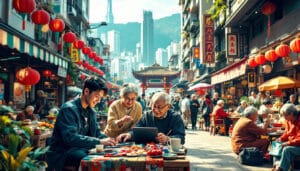Welcome to our platform, where your experience matters above all. We use cookies and data to improve our services. Your privacy is our priority.
We are committed to providing and maintaining our Google services optimally. By monitoring interruptions and protecting against spam, fraud, and abuse, we ensure a secure experience. Our goal is to measure our audience’s engagement and the site statistics to better understand the use of our services and thus improve their quality. If you choose to “Accept All,” we will develop and enhance new services, evaluate the effectiveness of advertisements, and display personalized content based on your settings. For those who prefer to “Reject All,” we will not use cookies for these additional purposes. The non-personalized content will depend on what you are currently viewing, your activity during your active search session, and your general location. For an age-appropriate experience, visit our section on additional options and manage your privacy settings at any time.

With the aging population, cities around the world recognize the importance of capitalizing on the aging economy. This demographic trend offers new economic and social opportunities, prompting local authorities to implement innovative strategies to meet the needs of seniors while stimulating economic growth.
Table des matières
ToggleWhat are the main axes of government initiatives?
The government recently presented a series of 30 initiatives aimed at boosting the aging economy. These measures cover various domains, ranging from health and well-being to employment and senior entrepreneurship. The main objective is to create a favorable environment where seniors can not only remain active and engaged but also make significant contributions to the local economy.
Among these initiatives are continuing education programs for seniors wishing to reintegrate into the labor market or start their own business. Grants and tax incentives have also been established to encourage businesses to adapt their services and products to the specific needs of elderly individuals.
Furthermore, the government invests in suitable infrastructures, such as leisure and health centers, which facilitate an active and autonomous lifestyle for seniors. These infrastructures play a key role in enhancing the aging economy by providing older people with opportunities for socialization, training, and economic participation.
To learn more about these initiatives, check out this detailed article.
How does the private sector contribute to this dynamic?
The private sector plays a crucial role in the energizing the silver economy. Companies are adapting their offerings to meet the specific needs of seniors, whether it’s through innovative health products, technologies that facilitate daily life, or personalized services. This adaptation not only captures a new clientele but also stimulates innovation and economic growth.
Partnerships between the government and the private sector are also crucial. By collaborating, they can develop holistic solutions that encompass the health, well-being, and social inclusion of seniors. For example, tech companies are partnering with health institutions to create connected medical devices that improve the quality of life for elderly individuals.
In China, the private sector has particularly understood the importance of this economy. Local companies are investing heavily in services dedicated to seniors, constantly innovating to meet the expectations of a rapidly growing aging population. For an in-depth analysis of this dynamic, refer to this article.
What benefits does the silver economy bring according to the IMF?
According to the International Monetary Fund (IMF), the silver economy represents a source of sustainable growth and economic stability. By investing in this economy, countries can benefit from an expanded workforce and increased consumption, which stimulates the health, leisure, and technology sectors. The IMF emphasizes that initiatives aimed at integrating seniors into the active economy contribute to economic resilience and reducing inequalities.
The IMF also highlights the importance of inclusive policies that address the challenges of aging, such as managing pensions and maintaining public health systems. By adopting a proactive approach, governments can transform demographic challenges into economic opportunities, thus promoting balanced and sustainable growth.
For a comprehensive presentation of the benefits according to the IMF, see this article.
What are the economic impacts of trade shows focused on the silver economy?
Trade shows dedicated to the silver economy have become essential platforms for the exchange of ideas and business opportunities. These events bring together key players from the public and private sectors, thus facilitating the creation of partnerships and the emergence of new initiatives. By showcasing the latest innovations and trends, these trade shows play a crucial role in promoting and growing the aging economy.
In Hong Kong, for example, trade shows are rapidly expanding, attracting thousands of visitors each year. These events not only highlight products and services tailored to seniors but also raise public awareness of the issues and opportunities within this specific economy.
The economic fallout from these trade shows is significant. They stimulate job creation, foster innovation, and strengthen the competitiveness of local businesses in the international market. To learn more about the impact of these trade shows, refer to this article.
How do local initiatives adapt to cultural specificities?
Initiatives aimed at leveraging the aging economy often need to be adapted to local cultural specificities to be effective. In some cultures, respect and care for the elderly are deeply ingrained, making it easier to implement dedicated programs. In others, it may be necessary to raise public awareness and promote the economic and social benefits of engaging seniors.
For example, in Hong Kong, government initiatives are designed with family and community values in mind, thereby encouraging active participation of seniors in economic and social life. Educational programs and awareness campaigns are implemented to promote the importance of including elderly individuals in various sectors.
Moreover, adapting services and infrastructures to the specific needs of seniors while respecting local traditions and customs is essential for the success of initiatives. This includes establishing community centers, adapted health services, and continuing education programs, thus ensuring a harmonious integration of seniors into the local economy.
What challenges must be overcome for a prosperous silver economy?
Despite the numerous opportunities offered by the aging economy, several challenges must be addressed to ensure its prosperity. Among these challenges is the need to reform pension and social security systems to make them sustainable in the long term. Effectively managing financial resources is crucial to avoid pressure on public budgets and ensure adequate support for the needs of seniors.
Another major challenge is adapting the labor market to the capacities and needs of older workers. This includes implementing policies that favor continuing education, flexible working hours, and adapted working conditions. Encouraging companies to value the experience and skills of seniors is also essential to maintain their employability and professional engagement.
Additionally, access to quality healthcare is a central issue. Ensuring effective and personalized care for seniors is vital to maintain their quality of life and active participation in the economy. Finally, combating age-related stereotypes and prejudices is crucial to fostering an inclusive society where every individual can fully contribute, regardless of their age.
What are the benefits for businesses investing in the silver economy?
Investing in the silver economy offers numerous benefits to businesses. By adapting their products and services to the needs of seniors, businesses can access a rapidly expanding market, resulting in increased sales and enhanced customer loyalty. Moreover, by developing innovative solutions for seniors, businesses stimulate their own capacity to innovate and strengthen their competitiveness in the market.
Companies that integrate seniors into their strategies also benefit from a positive brand image, demonstrating their commitment to an inclusive and sustainable society. This can attract new customers, partners, and talents, thus contributing to ongoing growth and diversification of activities.
Furthermore, by collaborating with public organizations and associations, businesses can take advantage of grants, tax credits, and other financial incentives, thereby reducing investment costs and increasing their profitability. For more information on the advantages for businesses, see this article.
How does the aging economy influence urban planning and infrastructures?
The aging economy has a significant impact on urban planning and the infrastructures of cities. Municipalities must rethink their urban spaces to make them more accessible and suited to the needs of seniors. This includes creating adapted housing, developing accessible public transport, and establishing safe pedestrian zones.
Health infrastructures also play a crucial role. Constructing specialized medical centers and modern nursing homes allows for effective responses to the growing healthcare needs of elderly individuals. Furthermore, integrating smart technologies into urban infrastructures can enhance seniors’ quality of life by facilitating their mobility and ensuring their safety.
Moreover, green spaces and adapted recreational areas promote an active and social lifestyle for seniors, contributing to their well-being and inclusion in the community. Thus, urban planning must be approached holistically, considering social, economic, and environmental dimensions to create inclusive and sustainable cities.
What success stories can be observed in other cities?
Several cities around the world have already successfully implemented initiatives to leverage the aging economy. For instance, Tokyo has developed numerous support programs for seniors, including advanced health services, adapted leisure activities, and employment opportunities for elderly individuals. These initiatives have helped maintain an active and engaged population while addressing the increasing needs for healthcare.
In Europe, cities like Barcelona and Copenhagen have adopted innovative approaches to urban planning, creating environments conducive to the mobility and autonomy of seniors. These cities invest in accessible public transport, green spaces, and healthcare infrastructures, thus ensuring a high quality of life for their aging populations.
In Hong Kong, as previously mentioned, trade shows dedicated to the silver economy have played a key role in developing this local economy. These events facilitate exchanges between public and private actors, thus stimulating innovation and economic growth. To discover more inspiring examples, visit this article.
How are technologies transforming the aging economy?
Technologies play a decisive role in transforming the aging economy. The rise of information and communication technologies allows for the development of innovative solutions to enhance the quality of life for seniors. From connected health applications to home automation devices, and adapted telework platforms, technologies facilitate the autonomy and inclusion of elderly individuals in society.
Virtual and augmented reality technologies offer immersive experiences that contribute to the mental and physical well-being of seniors by providing recreational activities and interactive therapies. Additionally, tele-assistance systems allow elderly individuals to stay connected with their loved ones and access emergency services quickly when needed.
Furthermore, technologies facilitate the management of urban infrastructures by making services more accessible and efficient. For example, intelligent transport solutions enable better planning of seniors’ travel, thereby reducing mobility constraints. Integrating these technologies into government initiatives and private strategies is essential to maximize the benefits of the aging economy.
What are the social impacts of the aging economy?
The aging economy has profound social repercussions. By promoting the inclusion and participation of seniors, it contributes to a more balanced and supportive society. Economic initiatives targeting elderly individuals encourage their active engagement, reduce social isolation, and strengthen intergenerational bonds.
Moreover, by valuing the skills and experiences of seniors, the aging economy promotes the transmission of knowledge and values within the community. This can manifest in mentoring programs, educational initiatives, and community projects where seniors play a central role.
On a family level, these initiatives also allow for better reconciliation between different generations, by providing solutions tailored to the needs of each. For instance, shared care services and intergenerational activities strengthen family and community ties, thereby creating a harmonious and inclusive environment for all.
How do public policies support the aging economy?
Public policies are essential for supporting and promoting the aging economy. Governments establish supportive legislative and regulatory frameworks that encourage innovation and investment in key sectors. These policies include grants, tax incentives, and support programs for businesses and initiatives dedicated to seniors.
Moreover, public policies focus on training and education, providing opportunities for professional development for seniors and promoting a culture of lifelong learning. This enables elderly individuals to remain competitive in the labor market and adapt to technological and economic changes.
Collaboration between different levels of government, as well as between the public and private sectors, is also crucial for the effective implementation of initiatives. By working together, public and private actors can develop integrated and sustainable solutions that address the challenges and opportunities of the aging economy.
To discover how the private sector collaborates with public initiatives, see this article.







